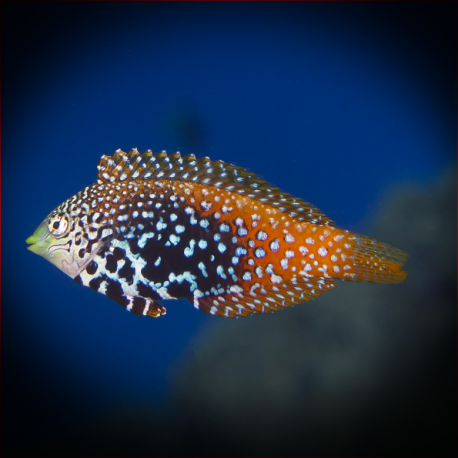More info
Datasheet
| Minimum Tank Size | 400 litres / 105.67 US gallons |
| Maximum Size | 13.0cm / 5.12inches |
| Reef Compatible | Always reef safe |
| Temperament | Docile |
| Temperature | 22.2°C / 71.96°F - 25.6°C / 78.08°F |
| Specific Gravity | 1.020-1.025 |
| Carbonate Hardness | 8-12 |
| pH | 8.1-8.4 |
General Description
The Blue Star Leopard Wrasse, scientifically known as Macropharyngodon bipartitus, belongs to the Labridae family, specifically the Macropharyngodon genus. These wrasses are characterized by their captivating colors and patterns, making them a visually stunning addition to reef aquariums.
Aquarium Suitability and Demands
Aquarists need to exercise caution when considering the Blue Star Leopard Wrasse for their tanks due to their specific dietary requirements. These fish thrive best in well-established aquariums where they can forage for small snails and pods. It is crucial to ensure that they have access to an ample food supply, as insufficient nutrition can lead to malnutrition and eventual death. They are best kept in tanks without competitors for food sources and should be fed a variety of frozen foods multiple times a day to supplement their diet adequately.
Care and Hardiness
Blue Star Leopard Wrasses have an average level of hardiness, making them relatively stable once established in a suitable environment. These fish exhibit docile behavior and prefer to dwell in environments free from aggressive tank mates to avoid feeding issues. Additionally, they have a unique habit of burying themselves in sand when feeling threatened or needing to rest.
Reef Suitability
The Blue Star Leopard Wrasse is considered reef-safe, making them a suitable choice for reef aquariums. These wrasses contribute positively to reef ecosystems by consuming unwanted invertebrates, such as flatworms and pyramid snails. Their presence in reef tanks can help maintain the ecological balance and aid in pest control.
Aquarium Setup
To cater to the specific needs of the Blue Star Leopard Wrasse, it is essential to provide a tank with a deep sandy substrate of at least 2 inches (5 cm) to allow for burrowing behavior. Aquarists should ensure the tank environment is peaceful, avoiding aggressive tank mates that may hinder the wrasse's feeding habits. Proper acclimatization and gradual introduction to the aquarium are crucial due to the species' sensitivity during transportation.
Behaviour
These wrasses exhibit shy and docile behavior, emphasizing the importance of selecting tank mates that are compatible with their temperament. Their ability to change gender from female to male adds an intriguing aspect to their behavior and reproductive dynamics.
Feeding and Diet
The Blue Star Leopard Wrasse thrives on a diet comprising small crustaceans such as krill, mysis, and artemia, along with zooplankton like cyclops and pods. Frequent feeding is essential, especially during the initial transition period, although the feeding frequency can decrease when the fish can obtain natural food sources within the aquarium.
Dimorphism
One intriguing aspect of the Blue Star Leopard Wrasse is its hermaphroditic nature, enabling individuals to change gender from female to male as needed. This unique biological characteristic adds complexity to their reproductive processes and social dynamics within a captive environment.
Habitat and Distribution
These wrasses are native to the East and West Indian Oceans and are commonly found in reef environments. Their distribution in these regions highlights their preference for tropical marine habitats with ample opportunities for foraging and burrowing in sandy substrates.

